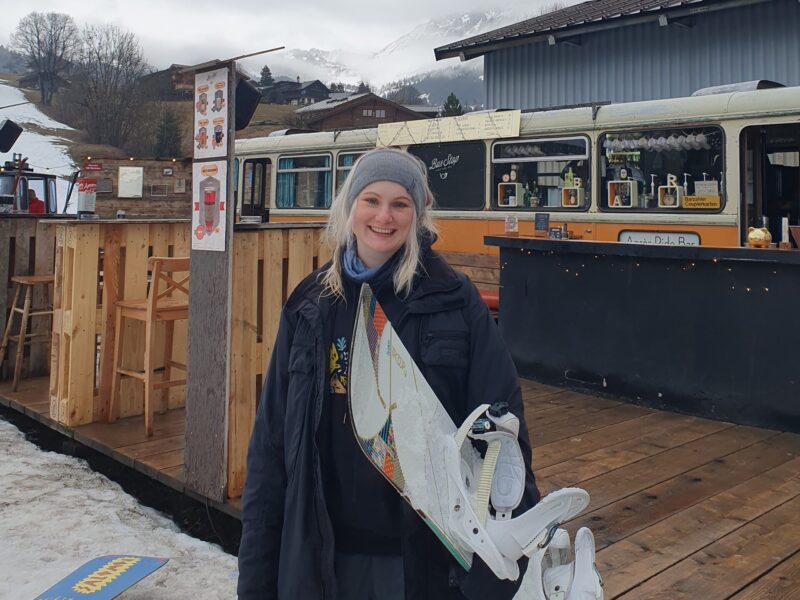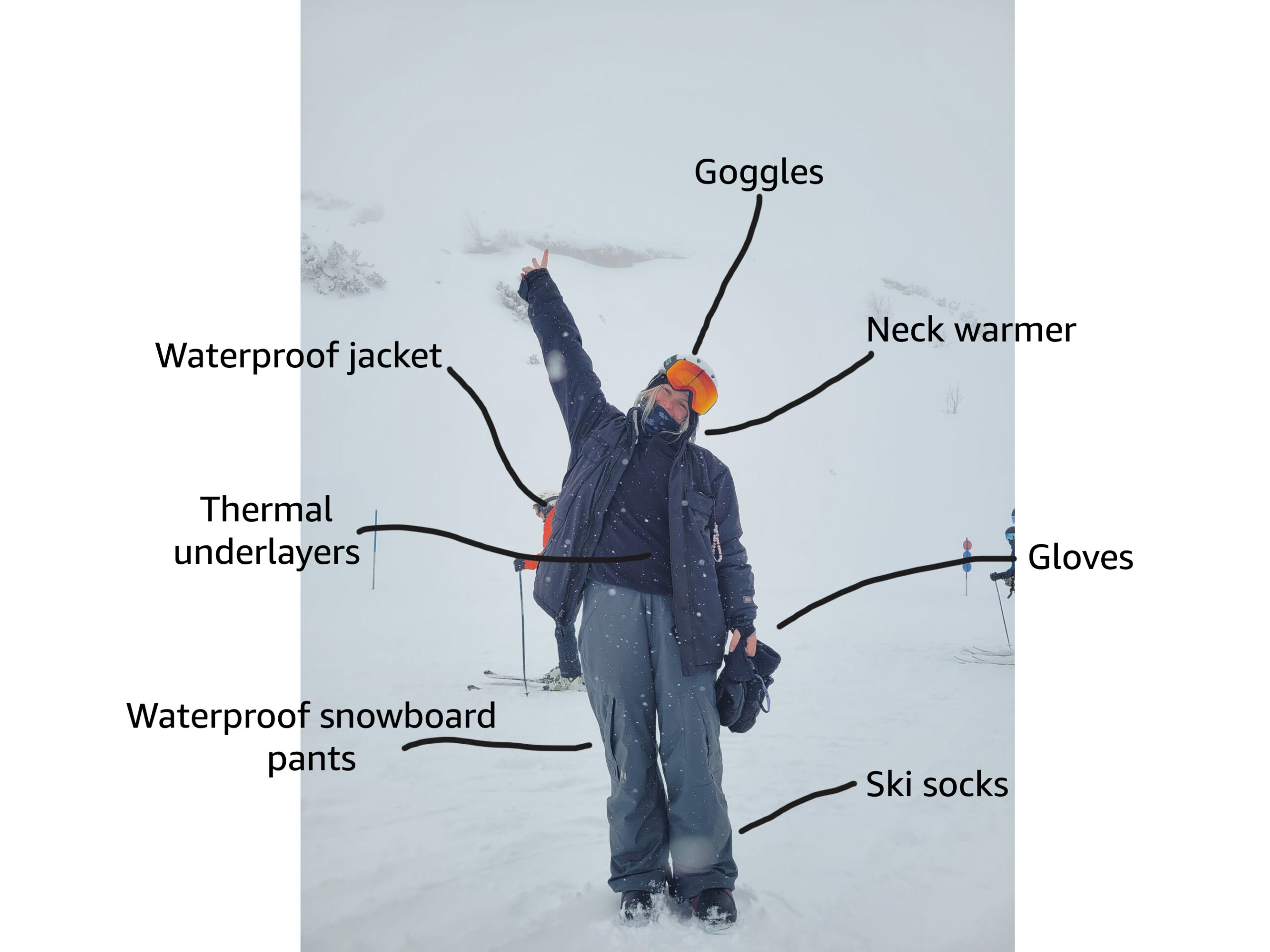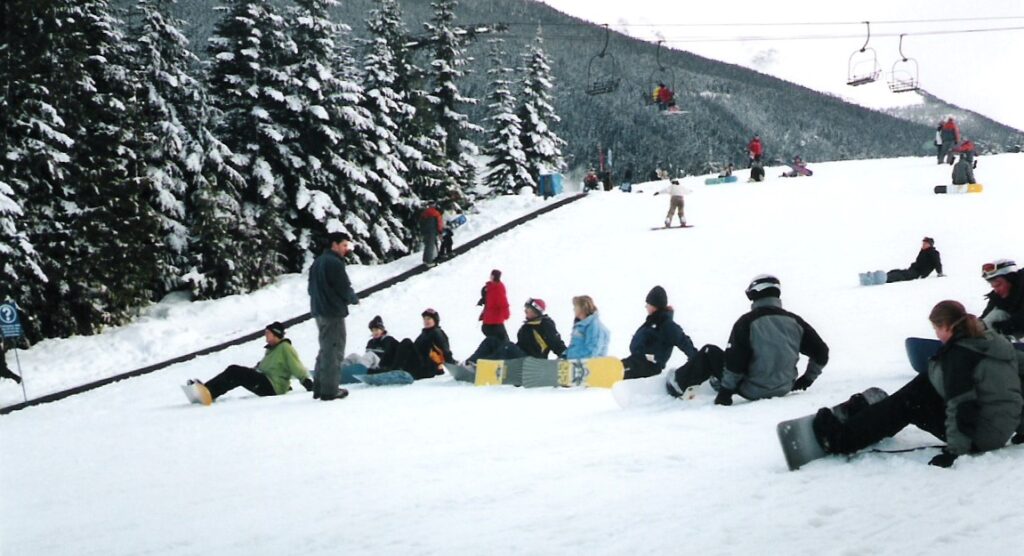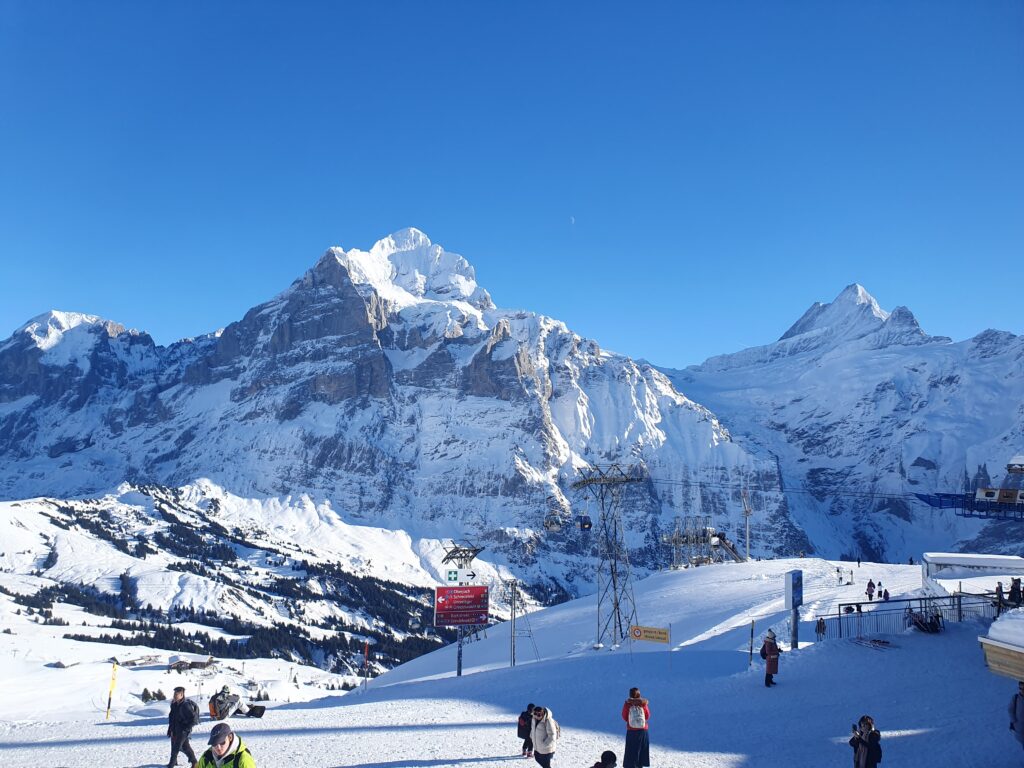Snowboarding for Women: Ultimate Beginner's Guide
Bell | 19 November 24
Whether you currently ski and are looking to switch tracks or have always dreamed of riding the slopes, this is the ultimate beginner guide to get started with snowboarding for women.
Snowboarding is often considered an extreme sport, which can feel overwhelming for those looking to get into it. On top of that, much of the snowboarding messaging and visuals we still see are of men. So, this is the ultimate guide by women for women on starting to snowboard.
From which equipment to get to how to feel comfortable as a beginner to where to start, I will share all my top tips and tricks in this guide.
This is also a reminder that you can start snowboarding at any age! While it is true that it’s easiest as a child as we are less afraid to fall, I personally only started at 15 and many of my students are over 30, even up to their 60s. With the right teacher, it is totally safe and very much possible to learn snowboarding at any age and fitness level.
Table of Contents
ToggleSnowboardHer may contain affiliate links to support the running of the blog. If you make a purchase through these links, I will earn a commission at no extra cost to you. Thank you.
How to get started with snowboarding
Why snowboarding?

Snowboarding is such a fun sport with incredible physical and mental benefits as well as a great community. It is very versatile, whether you love to just ride the piste, do tricks in the park or ride powder in the backcountry. It really has something for everyone. I personally feel like snowboarding allows for more “creativity” and a more relaxed atmosphere than for example skiing. It reminds me of the culture surrounding surfing.
My favourite thing to do is snowboard with some fellow ladies. It is the most supportive, kind and fun atmosphere and easily the best times I have had both on and off the mountain.
Physical and Mental Benefits
Snowboarding is a fantastic workout and on top of that, you get lots of fresh air. While snowboarding, you train not just your body but also strengthen your heart, lower your cholesterol, improve blood pressure and stimulate the metabolism. It is an incredible sport to get your entire body fit, from bone to muscle to heart.
I have also found that my mental health improves massively when I regularly get to snowboard. Like any exercise, it releases endorphins which reduce stress and help improve your mood. It is also a great way to gain more self-confidence, a sense of achievement that comes with succeeding at a new skill. Additionally, it’s a great way to interact with like-minded individuals and hence combat the loneliness that sometimes comes with the winter months.
In general, snowboarding has changed the way I view winter. I used to be terrified of the cold, dark months, but now they have become one of my favourite times of the year. I cannot wait to be on the slopes again.
Finding the Right Gear
This may be a surprise, but gear is not that important when learning to snowboard. At least not until you are starting to turn and go down blue slopes, which can easily take a week. So depending on how much you get to snowboard in a year, you may not need to buy equipment that first year.
I would in general not recommend buying gear until you have tried snowboarding for a few days and know you enjoy it. Gear becomes expensive very quickly. Most beginner lessons come with equipment rental for a small additional cost and while the equipment usually isn’t great, it is more than enough for those first few lessons.
Once you have had your first few lessons and know you want to stick with it, it is worth getting a beginner setup for yourself. This will help you improve quicker as it is more adjusted to your abilities.
That being said, I spent years riding on second-hand gear that may not have been ideal for me, but it did the trick. I even took my initial snowboard instructor exam on a second-hand board. Snow sports are quite expensive, so second-hand gear is a great way to make it more accessible. And don’t listen to those who sh*t on certain brands, it’s just misled arrogance – a good rider can ride any board.
Best Beginner Snowboard Gear
As we’ve mentioned, beginner snowboard gear does not need to break the bank. Check on Facebook Marketplace or eBay what second-hand boards are on sale in your area. The most important for this is that the board is the correct length (find the guide for that here – keep in mind a slightly shorter board is easier to handle) and the right model for your skill level. It doesn’t matter if it is an older variant, they will still work fine.
If you want to get a new setup, here is the snowboarding gear I would recommend for beginners (women):
Snowboard – Bataleon Feelbetter (I have this one and it’s great board beginner to advanced), Women’s Capita Paradise (easy to ride but great for progression), YES. Women’s Basic (super versatile)
Bindings – Union Rosa (great for improving, good control), Burton Citizen (cheap and good for learning), Ride CL-2 (good for improvement)
Boots – Vans HI-Standard Pro (I have these, they are great for beginner to advanced), Burton Mint (soft and forgiving for beginners), Thirtytwo Exit Snowboard Boots (affordable and good)
Helmet – Giro Ledge Mips (perfect for any snowboarder), Smith Vantage Mips, Sandbox Icon Snow Mips
Keep in mind that you HAVE TO try on helmets and boots before buying. They need to fit to your foot/head shape and what works for others may not work for you. For boots, they need to feel almost too small in the beginning as you do not want to start sliding. Also, your heel should under no circumstance lift in the boot.
What clothing do you need as a beginner snowboarder?

The right clothing and protection will make your first snowboard experience so much more enjoyable.
I would recommend good quality base layers, so thermal underwear and a middle layer that keeps you warm, such as a puffer vest or fleece. Over that comes the waterproof outer shell, a jacket and pants. They should have a minimum 10,000mm waterproof rating.
For gloves, I usually prefer mittens over finger gloves for snowboarding. Make sure these are waterproof – as a beginner you will spend a lot of time in the snow and I have seen too many with soaked, freezing gloves. You can buy waterproofing spray here.
I’d also recommend a neck warmer and something to keep your ears warm, especially when renting helmets which can often fit poorly and hence not be as warm.
I would also highly recommend some protective equipment for your first lessons. Impact shorts are great to cushion your butt and trust me, you will need them. I also recommend knee protectors as they will give you a crucial sense of security when practising turns.
Snowboarding lessons and the right instructor
Some people may disagree, but I personally think getting an instructor to start snowboarding is essential. The thing with snowboarding is that it may feel harder in the beginning to learn the “right” technique, rather than just going for it and getting down the mountain. HOWEVER, once you adopt the wrong technique or some funny quirks, they are incredibly hard to get rid of when snowboarding.
It is why you see so many snowboarders flailing their arms to do turns or constantly catching an edge – the basic technique is missing or not practised enough.
I have had so many intermediate lessons where people were struggling with turns or carving due to some basic issue with their technique. The majority were self-taught or by a friend/boyfriend. We often had to go back to the most basic exercises that are taught on the first day of lessons to fix the issue.
So, do yourself a favour and don’t skip those key initial lessons. I know they are expensive, but they will be so worth it in the end. I personally needed 4 days of lessons before my technique was starting to be correct and I was able to go down blue slopes. I still found out years later while taking my snowboard instructor exam that I wasn’t leading my turns with my lower body, a fault that should have been corrected in that first week of lessons.
Finding the right instructor
That is why it is so key to find the right instructor. A good starting point is going to an established ski school with good reviews. They will have a good vetting process for their instructor and should also be able to find the right one for your skill level.
This is down to personal preference, but I would always recommend a female instructor for women. They are able to relate to the learning process from their own experience and understand much more the difference in strength and how to make up for it.
I had quite a few tricks I was struggling with and all the YouTube videos by men were just not working for me. Last year during instructor training, one of the other girls explained how she did it and it immediately clicked. Our bodies are just different, not weaker, so we need to adjust accordingly.
Common mistakes to avoid
Here are some mistakes I see my beginners make almost daily that you can look out for:
- Not bending the knees – without bending your knees, turning is almost impossible
- Not choosing an edge – the famous saying “If you don’t choose an edge, the mountain will choose one for you” is true
- Using the upper body to turn instead of the lower body – you technically don’t need your arms at all to turn, focus on leading with your knees and hips
- Not looking where you are going – if you only look at your toes, you’re not going to get that far. Look at where you want to go, especially when turning.
Where to go snowboarding as a beginner

Technically, any resort is fine to start snowboarding. They all have beginner slopes and green/blue runs. That being said, some have more easy terrain with long runs that are perfect for practising. Others are more advanced resorts where even blue slopes feel difficult – Arlberg in Austria is one of them.
If you are on a budget, there are some great resorts in Eastern Europe where you can try the sport for cheap. Which is ideal for those first lessons and to figure out if you like snowboarding. On the other hand, some of the more famous resorts that are more expensive have very well-established snow schools with world-class instructors. It depends on what you are looking for.
Ski resorts that are good for beginner snowboarders
- Borovets, Bulgaria – the perfect beginner resort as it has mostly easy slopes, very cheap rentals and affordable lift passes, perfect for trying out snowboarding.
- Tignes, France – Lots of easy slopes combined with a great apres-ski life, the ideal beginner resort.
- Vogel, Slovenia – super affordable ski passes and rentals with dedicated learning areas
- Soll, Austria – big number of blue runs which are great for practising and some free lifts in the beginner area
- Levi, Finland – sometimes referred to as the “beginner’s paradise”, this resort is ideal to start out
- Nozawa Onsen, Japan – 40% of beginner ski areas with the abundant snowfall that Japan is known for
How to prepare for your first time snowboarding
There are a few things you can do prior to your first time snowboarding to set yourself up for success. The first is having a basic level of physical fitness and mobility. Snowboarding gets extremely difficult if you don’t have mobility as you may not even be able to get up by yourself. A base level of strength will mean you can balance better and make it through the day.
Eating well before your lesson with lots of protein will also help you have enough strength for the day. Bring snacks as well for when you need that extra energy.
The right clothing and protective equipment as discussed previously are also key when preparing for your first time snowboarding. They can easily make or break your day.
Lastly, watch some YouTube videos to get a feel for what it should look like. The real thing is very different and much harder than it may look on YouTube, but getting an idea of what advanced snowboarders look like helps you visualise why your instructor is doing certain exercises. Just don’t turn up to your lesson claiming YouTube has already taught you all you need to know 😉
Exercises to prepare for snowboarding
- Stretching and Mobility – these exercises are crucial to safely performing tricks but even just getting your snowboard on. If you can’t reach past your knee when bending down, you may find it difficult to put your snowboard on while sitting. Yoga and Pilates are both great for this.
- Cardio – I personally love to jump rope as it is great cardio and strengthens my entire body, but running or any other form of cardio will prepare you for long days on the slopes.
- Lunge with Rotation – strengthens all the right muscles for snowboarding
- Jumping Squats – great for strengthening leg muscles and increases resistance
- Single Leg Deadlift to High Knee – helps with balance, strength and control and works legs and core
How to stay safe on the slopes

Accidents on the slopes are very dangerous and often avoidable. There are a few key rules you need to follow to keep yourself and others safe:
- Don’t just stop in the middle of the piste or where you are not visible e.g. after a bump. If you need to stop, slowly head to the side and make sure you are well visible from above.
- Wear a helmet. It doesn’t look “cool” if you don’t, it just makes you look stupid because that’s what it is. Even if you are a great rider, someone else can take you out in the blink of an eye.
- Stay within your ability. Don’t head to more advanced slopes unless you are sure you can safely make it down!
- Check your gear before you get started. Make sure bindings are closed and don’t wiggle around, your helmet is on and your snowboard is serviced.
- Those in front of you have the right of way. Always. You can see them and they probably can’t see you, so if anything happens YOU are at fault. Control your speed so you don’t run into them.
I hope you found this helpful. Put any further questions you may have in the comments and I’ll answer them, or get in touch via social media!
Happy shredding!
